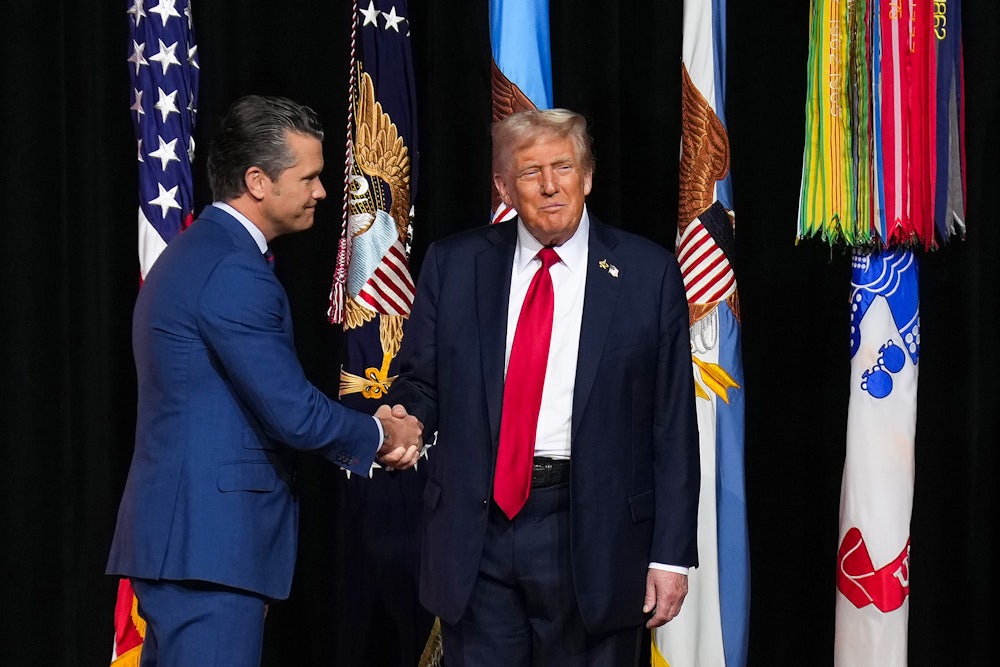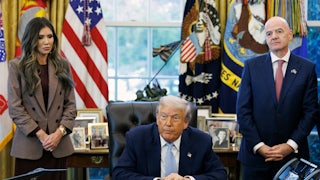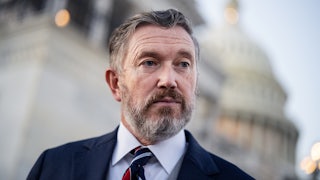Ever since Secretary of Defense Pete Hegseth announced that he was calling an all-hands-on-deck meeting of generals and flag officers and their senior noncommissioned officers at the Marine Corp base at Quantico, Virginia—and President Trump announced that he’d drop in—people in uniform and out have wondered: WTF? Now, having seen the Hegseth-Trump show, the question remains.
The only way to begin to solve this puzzle is to analyze each piece and then try to see how they might fit together. That’s not easy. A gathering such as this is unprecedented and, from a national security standpoint, entirely unwarranted. Why would the administration go to such lengths and take the risk of putting together the entire senior leadership in one place, at one time, make it known to the entire world, and put it all on video? The answer lies in the combination of the messages promoted by Hegseth and Trump: Hegseth’s fetish for “lethality” meets Trump’s “enemy within.”
Perhaps the most telling line in Hegseth’s speech outlining the changes he’s planning was that “all I ever wanted as a platoon leader” was relief from “politically correct and overbearing rules of engagement” that hampered “maximum lethality and authority for warfighters.” This is the lieutenant’s-eye view, divorced from laws of war, politics, policy, or even strategy; just the “unleash[ing] of overwhelming and punishing violence on the enemy.”
In Hegseth’s mind, any and all constraints on “warriors” are “infections” stemming from “social justice, politically correct and toxic ideological garbage” imposed by previous administrations, leaving military leaders “walking on eggshells.” He promises to reduce the power of inspectors general and equal opportunity officers and to erase “earnest or minor infractions” from personnel records: “You should not pay for earnest mistakes for your entire career.” Among the things that brought Hegseth to Trump’s attention in the first place were his efforts to grant pardons—which Trump granted—to those convicted of war crimes in Iraq and Afghanistan.
In sum, Hegseth wishes to divorce Americans in uniform from the rest of the country, indeed to elevate them to a distinct warrior class. “We are not civilians,” he said, as though he were still a military member himself. “You are not civilians. You are set apart for a distinct purpose.”
And what purpose would that be?
Trump supplied the answer: “We’re under invasion from within, no different than a foreign enemy but more difficult in many ways because they don’t wear uniforms. At least when they’re wearing a uniform, you can take them out.” The invaders are to be found in cities “run by radical-left Democrats … San Francisco, New York, Chicago, Los Angeles; we’re going to straighten them out one by one.”
And this will be a job for the military, says the commander in chief: “A major part for some of the people in this room. That’s a war too. A war from within.”
It will be a war fought by Hegseth’s rules of engagement. Trump told the assembled leaders a story about a protester spitting in a soldier’s face and the soldier not responding “though he wants to knock the hell out of the person.” Trump told the audience, “If it’s OK with you, generals and admirals, I’ve taken that off. I say, they spit, we hit. Is that OK? I think so.”
To their very great credit, the senior leaders sat through these harangues in stony silence, even when invited by the president to applaud. The American tradition of civil-military relations is deeply embedded in today’s officer and NCO corps—indeed, the ethos of military professionalization, of violence controlled by law and discipline, is cherished, far above any “warrior” ethos. George Washington is an American hero. Achilles is not.
And thus the question becomes not “what?” but “why?”
Because what Trump and Hegseth want is anathema to military leaders. The corporate leadership of America’s armed forces is not on board with the idea of unleashing “overwhelming and punishing violence” against the “invaders from within.” Nor can they be enthusiastic about Trump’s suggestions to use U.S. cities as “training grounds” for urban warfare; the recent deployments to Los Angeles and elsewhere were unpopular among many troops. Janessa Goldbeck, a Marine Corps veteran who runs the Vet Voice Foundation, reported that “the feeling [among the Marines] was that the Marines are being used as political pawns, and it strains the perception that Marines are apolitical.” National Guardsmen did not sign up to pick up trash or spread mulch in the nation’s capital.
Beyond the domestic deployments, the doubtful legality of missions such as the administration’s campaign of striking supposed drug-running speedboats in the Caribbean sends a chill through the ranks. In addition to fundamental moral questions, the threat of later prosecution for summary killings of noncombatants is a serious one; the administration’s firings of senior service judge advocate generals for political reasons is making troops wary of the legal advice they’re getting.
There have also been rumblings of deeper divisions, notably in regard to the National Defense Strategy, the Pentagon document that sets overall priorities and policies for the department. As in the previous Trump administration, this year’s update was expected to be focused on China, its growing military power and aggressive diplomacy. But earlier this month, Politico reported a major shift in emphasis toward defending the homeland and the Western hemisphere—in other words, an “America First” strategy that would also justify the domestic use of force.
This change—which also would fundamentally upend previous military planning, procurements, and overseas posture—has drawn strong pushback from senior military leaders, including Trump’s handpicked chaiman of the Joint Chiefs of Staff, Air Force Gen. Dan Caine. The “combatant commanders” who lead U.S. troops in various theaters are said to have unanimously “non-concurred” with the strategy.
Against such a backdrop of such basic disagreements, the Trump-Hegseth performance has a kind of lugubrious logic. It’s “weapons free” in Portland.
Trump has yet to make the military—at least at the most senior ranks—into “his military,” but the Quantico show should be seen as a step in that direction. And even if today’s generals and admirals stand firm, the suggestion to ambitious younger officers is clear: Be lethal, be loyal. Of all of Trump’s assaults on American democracy, a politicized, praetorian military “working toward the Fürher,” in historian Ian Kershaw’s phrase, would be the most frightening.






